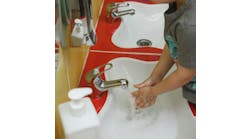When Mother Nature is stingy with rainfall, communities often restrict water use to conserve water. But as the U.S. population expands into more arid, drought-stricken areas, the increasing demand for water can stress water districts even in years that see average water supplies.
That puts education facilities, which use large amounts of water, under greater pressure to limit water consumption. The good news is that schools can take reasonable, cost-effective steps to cut water usage in restrooms, which typically are where schools use the most water.
The California House of Representatives recently passed Appropriations Bill 2496 (AB 2496). This legislation would require all tank-type water closets, including pressure-assist units, installed in new buildings after Jan. 1, 2008, to use no more than 1.3 gallons per flush (gpf) or 4.9 liters per flush (lpf).
As of Jan. 1, 2009, most water closets with automatic flushing systems would be allowed to use no more than an average of 1.3 gpf/4.9 lpf, and newly installed urinals would have consumption limits of 0.5 gpf/1.9 lpf. The bill also would allow the use of dual-flush systems, which would enable users to select either a full flush or an ultra-water-conserving flush, with a ratio of 1:2. That is, dual-flush systems can have one flush of 1.6 gpf/6.0 lpf for solids to every two flushes of 1.1 gpf/4.2 lpf for liquids. This results in a combined effective flush volume. Essentially, this means a 20 percent drop in toilet flushing and a 50 percent drop in urinal flushing.
Many plumbing technologies on the market will conserve water. If more facilities installed these fixtures, such as 0.5 gpf urinals, no-water urinals, 1.0 gpf/3.8 lpf pressure-assist toilets and sensor-operated faucets, indoor water consumption would drop considerably.
According to California assembly member John Laird, AB 2496's sponsor, the bill would save California an estimated 8 billion gallons of water per year after a 10-year startup period.
Great rewards
A common approach to encouraging retrofits has been to issue rebates to water district customers who replace older toilets with high-efficiency toilets (HETs). Those are defined as fixtures that have an effective flush volume that does not exceed 1.28 gpf/4.8 lpf.
About 39 municipal water districts offer either an exchange or toilet-rebate program for commercial or residential water customers to help meet conservation goals. These programs have differing financial incentives and side benefits, such as free delivery and installation of the new toilet. Several of these municipalities, which span nine states, are phasing out their 1.6 gpf programs and installing HETs.
Although each water district sets its own parameters, most call for installing products from an approved list of toilets. This is one reason why education facilities in the Denver area have not taken advantage of the local water district's toilet-rebate program. Many of the schools use wall-hung toilets, and the rebate program does not include any HET wall-hung units. If schools were more informed about their options, their participation and subsequent benefits would be likely to rise.
Lack of interest also stems from a perception that the water crisis is over and conservation efforts no longer are necessary. Although Denver water users showed great interest in conservation during the region's drought in 2003, participation has been more lackluster now that the drought has passed. Water conservation for the sake of long-term environmental interests is a harder sell.
A step ahead
Education facility managers shouldn't wait for their municipalities to issue drought warnings or to dangle incentives before they consider installing or retrofitting with water-conserving plumbing fixtures. Even if local water levels are adequate or no rebate initiatives are offered in a school's area, sound reasons exist for schools to purchase plumbing conservation systems.
David Carson, maintenance coordinator for Christopher Newport University's Ferguson Center for the Arts in Newport News, Va., says that his interest in new flushing technology is partially about conserving as much water as possible while properly accommodating the center's performing-arts patrons.
“In one evening performance, we can have 1,700 people going through, and that's a lot of water and a lot of flushes,” he says. “With anywhere from two to three shows a night, or maybe even four to five in a weekend, it adds up quickly.”
The Ferguson Center already uses automatic flushing systems in one part of the building, and Carson would like to retrofit the rest of the center's manual flush valves with electronic sensor operation to gain more of the sanitary and convenience advantages that come with automatic flushing.
“As far as cleaning goes, we've saved time and effort,” says Carson.
The center's two or three housekeepers have only 15 to 20 minutes between shows to clean the restrooms, and the automatic flushing systems have helped cut their workload.
Maintenance calls to fix leaky toilets also have been reduced because of touch-free flushing. “A lot of people use their foot to flush the commode, and that's hard on the fixture,” he says.
Faucet fix
Although local and federal legislation about restroom plumbing systems most often focuses on water closets and urinals, it also would be wise for education facilities to look into electronic faucets, which typically have a flow rate of 0.5 gallons per minute. Restroom users sensitive to picking up germs appreciate touch-free, sensor-operated faucets, which turn on automatically when hands enter the sensor zone.
For facility managers, the reverse of the process is where their benefits come in. When users' hands leave the sensor zone, during lathering or after rinsing, the water turns off. By turning off automatically instead of running continuously as manual faucets usually do, as much as 1 gallon of water can be saved per washing. Facility managers also report less maintenance with touch-free faucets. Without handles or knobs, sensor-operated faucets are less prone to everyday wear and tear, as well as intentional abuse.
Students have become more environmentally conscious than past generations and also are more aware of the importance of effective hand washing, and other health and hygiene issues.
Water-conserving plumbing fixtures come with too many additional advantages to ignore. Installing fixtures that are good for the environment is good for operations and maintenance, too.
Allen directs the Water Conservation Division of Sloan Valve Company, Franklin Park, Ill., which makes water-conserving plumbing systems.
NOTABLE
20
Percent decrease in toilet flushing that can result from using dual-flush systems.
50
Percent decrease in urinal flushing that can result from using dual-flush systems.
8 billion
Gallons of water per year, after a 10-year start-up period, that would be saved if California's Appropriations Bill 2496 is enacted.

